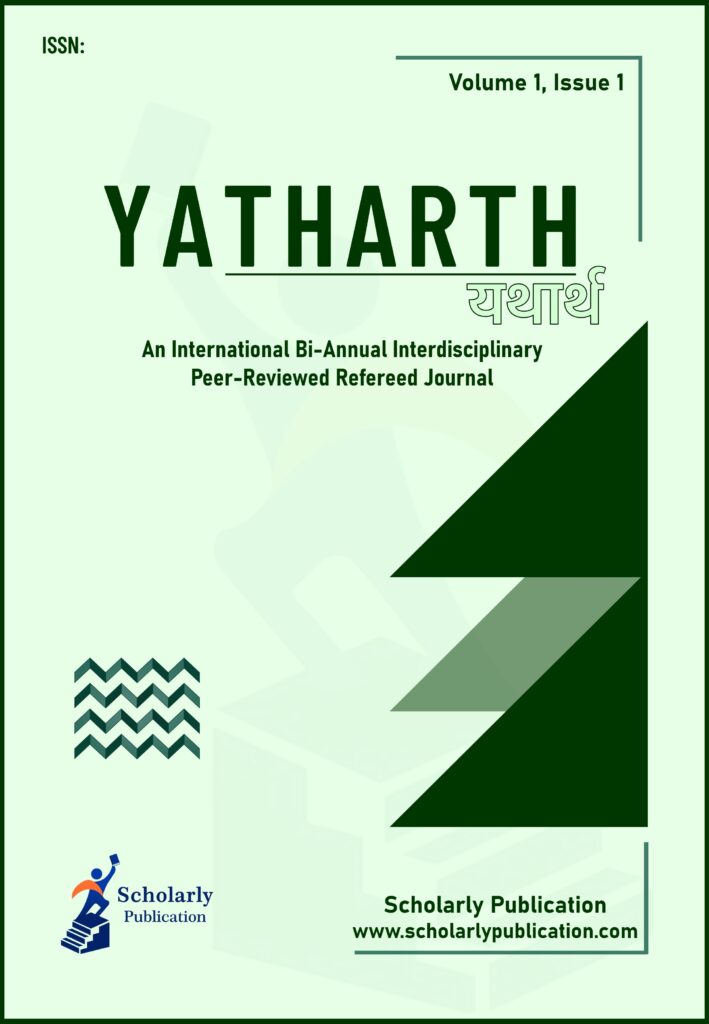Reviving tradition: Technological advancements in Blue Pottery art during covid-19 pandemic - A case study of Kot Jewar village
Volume 1, Issue 2, Article Number: 252001 (2025)
Home >> Yatharth >> Volume 1, Issue 2
1Research Scholar, Department of Sociology and Social work, IIS (Deemed to be University), Jaipur, India, 302020
2Assistant Professor-Selection grade, Department of Sociology and Social work, IIS (Deemed to be University), Jaipur, India, 302020
*Corresponding Author: mswami976@gmail.com
Received: 06 June 2025 | Revised: 01 July 2025
Accepted: 03 July 2025 | Published Online: 04 July 2025
DOI: https://doi.org/10.5281/zenodo.15802993
© 2025 The Authors, under a Creative Commons license, Published by Scholarly Publication
Abstract
Artisans are considered as the backbone of India’s non-farm rural economy. The handicraft and handloom industry are the second-largest source of employment after agriculture in India, as per Ministry of Textiles, Government of India. The Indian handicraft sector is indeed a blessing for the nation and its people. Blue Pottery art is exclusively practiced in Rajasthan, specifically in Kot Jewar village, which is approximately 45 km away from Jaipur city. After the pandemic hit the country, the artisans of the country suffered a lot. However, COVID proved to be both a boon and a bane for the artisan community. ‘Technology is a blessing in disguise’, social media platforms have helped the artisan community to promote their art, and they tried to create awareness about the dying, GI-tagged, art Blue Pottery. The objective of this paper is to discuss the impact of technology on Blue Pottery art and how it helped the artisan community to boost their work during covid-19 pandemic. The researcher used Mixed method approach; Qualitative research and quantitative research for the study. Based on the findings of the study, there is a huge market for Blue Pottery products, and there is a need to enlighten the artisan on how to utilise information technology tools in order to enhance the business. It is impossible to ignore the significance of environmental sustainability. Innovations like eco-friendly materials and solar-powered kilns will ensure that pottery-making survives for future generations while also reducing the industry’s environmental impact.
Keywords
Artisan, Blue Pottery, Covid -19 Pandemic, Handicraft Sector, Technology
References
- Gotra, A., & Lakhera, L. P. (2022). Socio-economic consequences of Covid-19: A case study of Lakhanpur town of Kathua District in J&K. In M. S. Negi & R. Bhatt (Eds.), Impact of Covid-19 pandemic: Pandemic on health and livelihood,153-166. Pathak Publisher and Distributor.
- UNESCO Institute for Statistics. (n.d.). Craft or artisanal products. UNESCO UIS.
- Development Commissioner (Handicrafts). Compendium of Handicrafts Schemes. Office of the Development Commissioner, Ministry of Textiles.
- Shrivastava, S. (2020). Sustainable approaches to rejuvenate the handloom and handicraft in India. Journal of Textile Engineering & Fashion Technology, 6, 241-248.
[View Article] [Google Scholar]
- Yadav, U. S., Tripathi, R., Tripathi, M. A., Ghosal, I., Kumar, A., Mandal, M., & Singh, A. (2023). Digital and innovative entrepreneurship in the Indian handicraft sector after the COVID-19 pandemic: challenges and opportunities. Journal of Innovation and Entrepreneurship, 12, 69.
[View Article] [Google Scholar]
- Chen, X., & Li, B. (2022). Rethinking cultural creativity and tourism resilience in the post-pandemic era in Chinese traditional villages. Sustainability, 14, 12371.
[View Article] [Google Scholar]
- Dalal, A., & Chattopadhyay, S. (2022, January). A Preliminary Study on Popularizing Indian Handicrafts Using Internet Technology–A Bengal Specific Study. In 2nd International Conference on Sustainability and Equity (ICSE-2021), 52-58. Atlantis Press.
[View Article] [Google Scholar]
- Shah, A., & Patel, R. (2017). Problems and challenges faced by handicraft artisans.Voice of Research, 6, 57–61.
- Dash, M., & Mishra, B. B. (2021). Problems of handicraft artisans: An overview.International Journal of Managerial Studies and Research, 9, 29–38.
[View Article] [Google Scholar]
- Dhamija, Jasleen. (2008). Kamaladevi Chattopadhyay. National Book Trust, India.
- Bordia, L. (2014). Jaipur Blue Pottery- a tribute. Neerja International Inc., Jaipur.
- Renu, & Anupama. (2018). Digitalisation: An aid in marketing of handicrafts. Journal of Emerging Technologies and Innovative Research (JETIR), 5, 294.
[View Article] [Google Scholar]
- Sharan, V. D., Priya, A., & Shrivastava, M. K. (2020). Crafting the way forward: Sustainability model for Indian rural artisans. International Journal of Management (IJM), 11, 3028-3036.
[View Article] [Google Scholar]
- Sodhi, G. J. (2006). Traditional potters and technological change in a North Indian town. Sociological Bulletin, 55, 367-382.
Cite This Article
M. Swami and P. Sharma, “Reviving tradition: Technological advancements in Blue Pottery art during covid-19 pandemic – A case study of Kot Jewar village,” Yatharth 2(1) (2025) 252001. https://doi.org/10.5281/zenodo.15802993
Rights & Permission
This is an open access article published under the Creative Commons Attribution (CC BY) International License, which allows unrestricted use, distribution, and reproduction in any medium, provided the original work is properly cited. No permission is needed to reuse this content under the terms of the license.
For uses not covered above, please contact the Scholarly Publication Rights Department.

